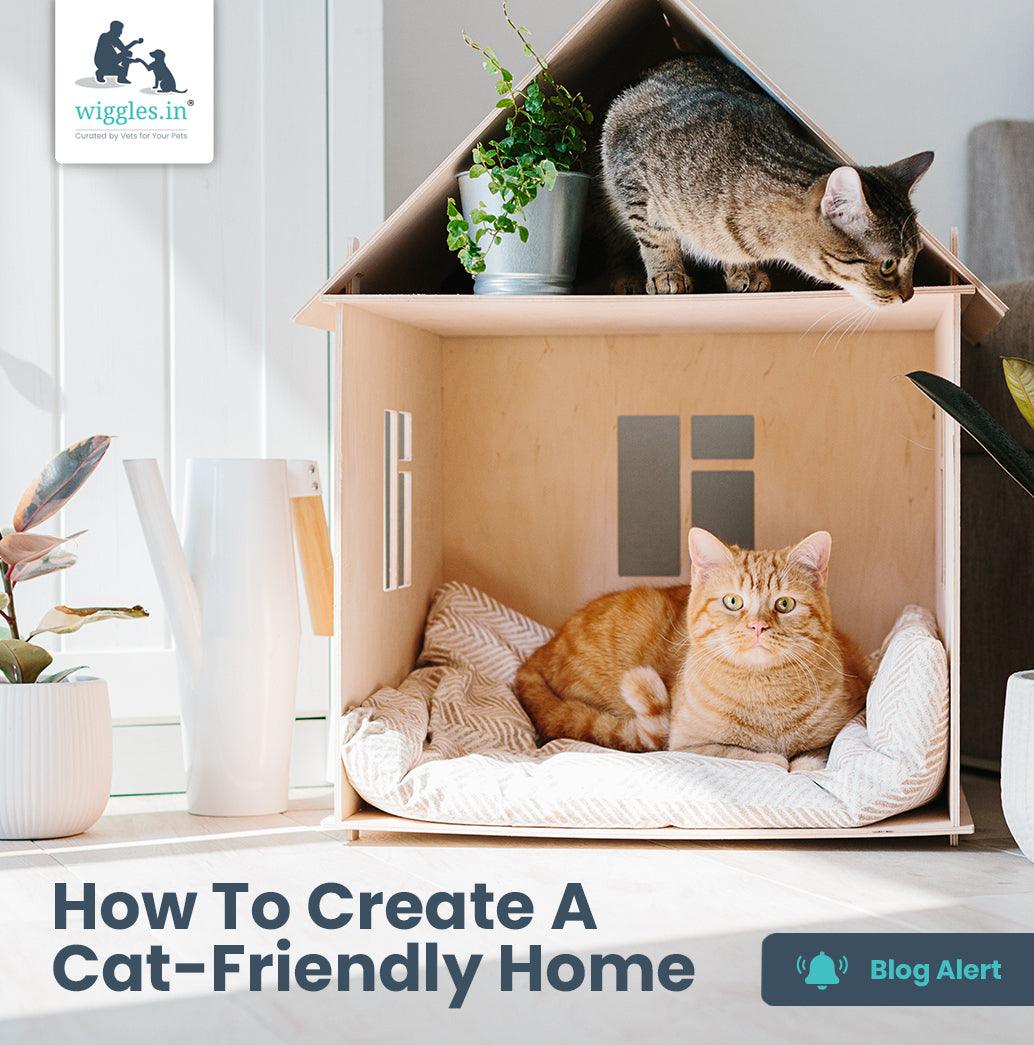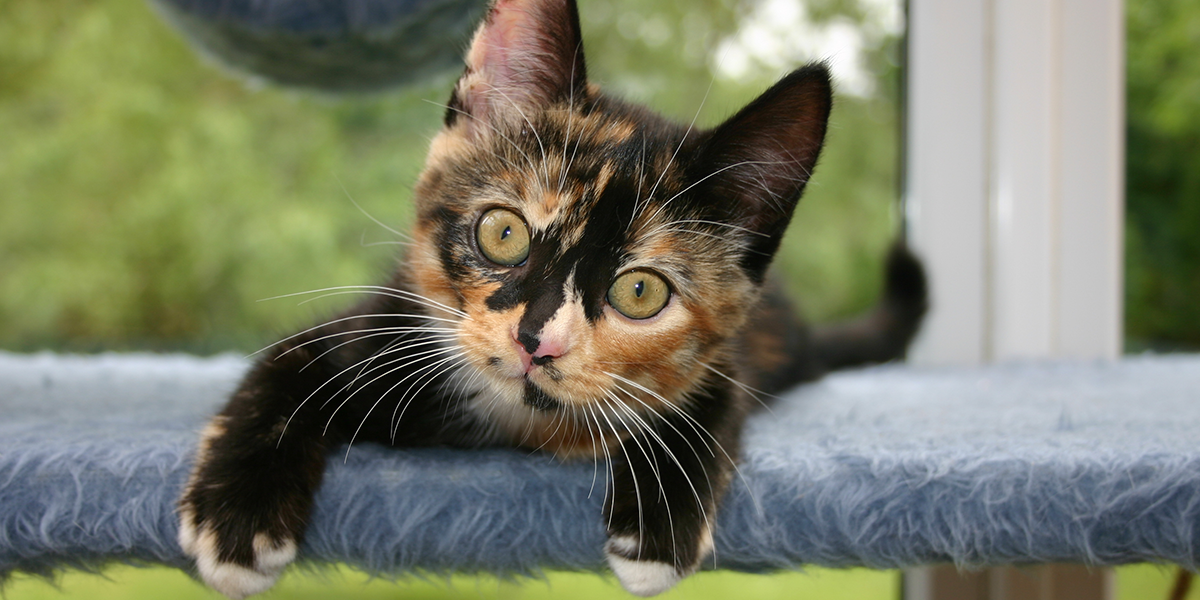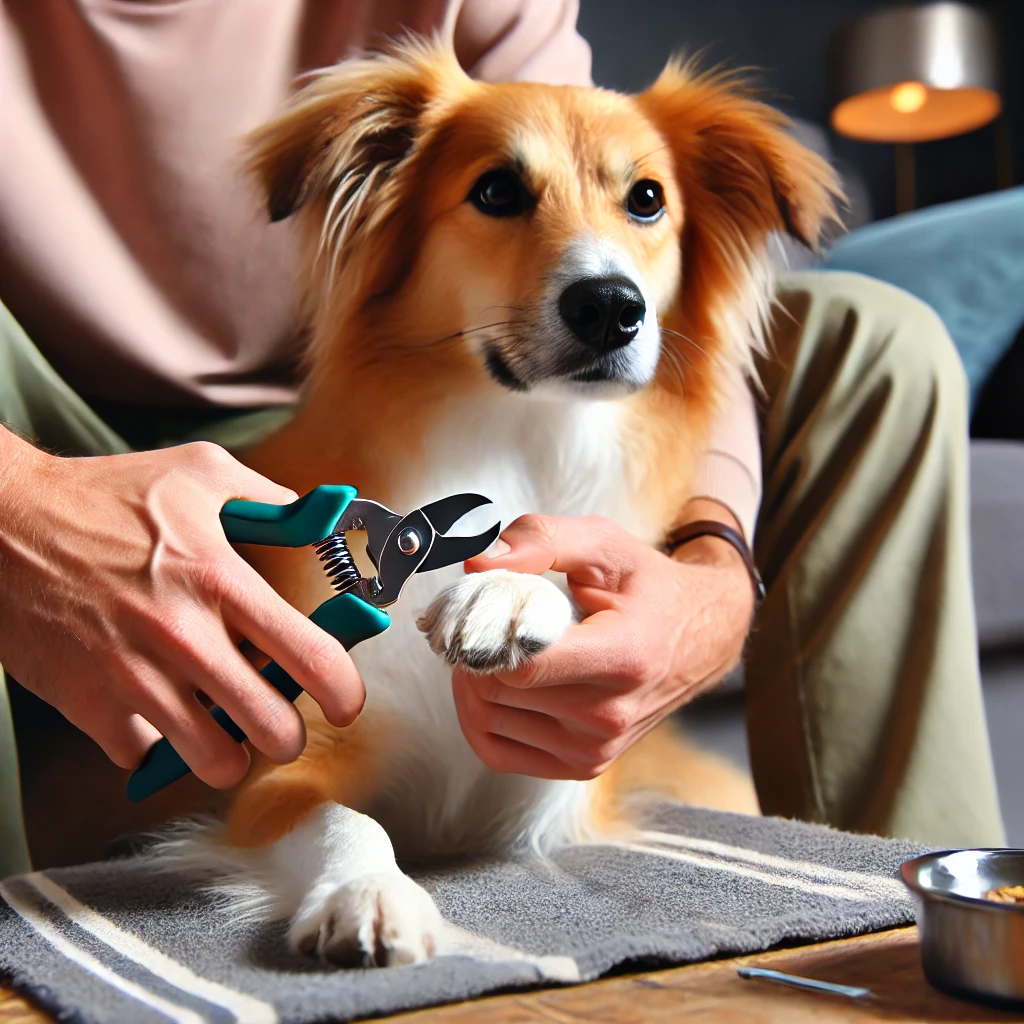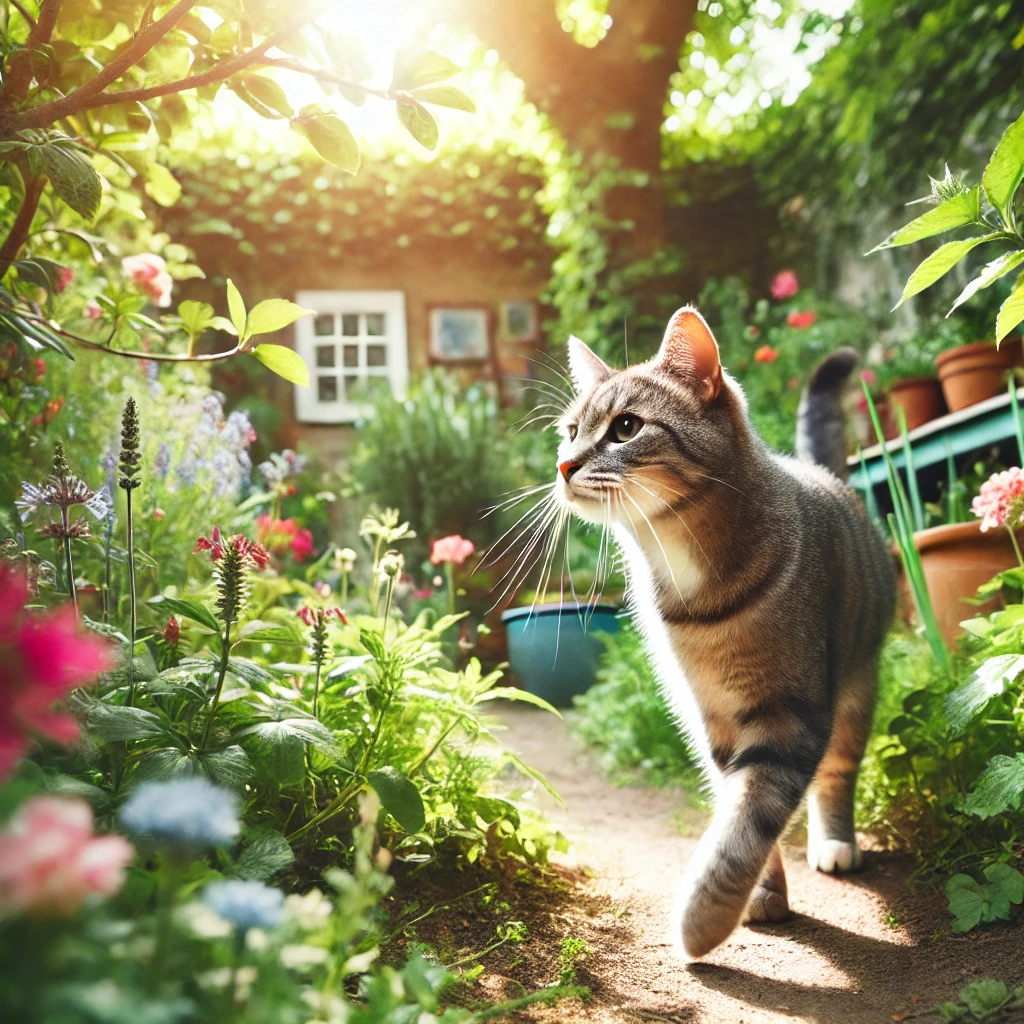Create a cat-friendly home by providing windows with perches for mental stimulation, regularly moving beds and perches, and encouraging climbing. Additionally, use puzzle feeders, interactive toys, and schedule interactive playtime for your cat’s entertainment and well-being.
Furthermore, make your home safe, comfortable, and quiet for your cat to rest undisturbed. Incorporate multiple litter pans, food, and water stations, and create a private and secure place for your cat to retreat to. Lastly, provide opportunities for play and predatory behavior, as well as positive and predictable human-cat social interaction.
By following these tips, you can set up a safe and stimulating environment for your feline friend in your home.

Credit: www.wiggles.in
Catering To Your Cat’s Comfort
Catering to Your Cat’s Comfort is essential for creating a cat-friendly home. By ensuring your feline friend has a cozy and safe environment, you can help them feel secure and content. From choosing the right bedding to creating hideaways, providing comfort for your cat is a crucial aspect of their well-being.
Choosing The Purr-fect Bedding
When selecting bedding for your cat, opt for soft, washable materials that provide comfort and warmth. Consider a plush cushion or a cat bed with raised edges to give your pet a sense of security. Additionally, ensure the bedding is placed in a quiet and peaceful area of your home, away from noisy spaces.
Creating Cozy Hideaways
It’s important to offer your cat secluded spaces where they can retreat and relax. This can be achieved by providing covered beds, cat trees, or even cozy cardboard boxes for them to snuggle in. These hideaways allow your cat to feel safe and secure, reducing stress and anxiety.
Feeding Feline Fun
Interactive Toys And Puzzles
Interactive toys and puzzles are essential for keeping your cat engaged and entertained. Look for toys that encourage your cat to use their natural hunting instincts, such as feather wands, laser pointers, or puzzle feeders. These toys provide mental stimulation and physical activity, helping to prevent boredom and encourage healthy behavior.
Incorporating Play Into Daily Routine
Incorporating play into your cat’s daily routine is crucial for their overall well-being. Schedule regular interactive play sessions with your cat using toys that encourage jumping, pouncing, and chasing. This not only provides physical exercise but also strengthens the bond between you and your feline friend.
Vertical Ventures For Vigorous Felines
Cats are known for their natural curiosity and love for climbing. Providing them with vertical spaces not only fulfills their instinctual need to climb and explore, but also ensures they have a safe and stimulating environment. In this section, we will discuss two important aspects of creating vertical ventures for your feline friend: installing cat shelves and trees, and maximizing window perch potential.
Installing Cat Shelves And Trees
One effective way to create vertical space for your cat is by installing cat shelves and trees. These structures not only serve as climbing platforms, but also provide cozy resting spots. When choosing cat shelves or trees, opt for sturdy and durable materials that can withstand your cat’s playful antics. Ensure that they are securely attached to the wall or floor to prevent accidents.
By placing cat shelves at different heights, you can encourage your cat to engage in vertical activities. Start with lower shelves for easy access and gradually increase the height as your cat becomes more confident. Adding carpet or sisal surfaces to the shelves can provide traction and allow your cat to scratch, fulfilling their natural instinct while also protecting your furniture.
Maximizing Window Perch Potential
Cats are naturally drawn to windows as they provide a source of mental stimulation and entertainment. Installing window perches can create the perfect vantage point for your cat to observe the outside world. Choose perches that are sturdy and attach securely to the window frame, ensuring your cat’s safety.
Position the window perches near windows with a view, allowing your cat to watch birds, squirrels, and other outdoor activities. Consider placing a bird feeder or bird bath outside the window to attract more wildlife, further enhancing your cat’s visual stimulation.
Remember to regularly rotate the location of your cat’s perches and beds to mimic a changing outdoor environment. This will keep your cat engaged and prevent them from becoming bored with their surroundings.
In conclusion, creating vertical ventures for your cat is essential in providing them with a stimulating and safe environment. Installing cat shelves and trees, as well as maximizing window perch potential, can keep your cat entertained and fulfilled. By incorporating these elements into your cat-friendly home, you are ensuring that your feline companion can indulge in their natural climbing instincts and enjoy the world from new heights.

Credit: www.petangel.com.au
A Safe Sanctuary
Create a cat-friendly home by offering stimulating environments with access to windows for mental stimulation and encouraging exploration. Regularly move beds and perches to mimic outdoor changes and promote climbing. Provide interactive toys, vertical spaces, and a safe, quiet place for your cat to rest undisturbed.
Minimizing Household Hazards
When creating a safe sanctuary for your cat, it’s important to minimize household hazards. Cats are curious creatures and can easily get into trouble if certain items are within their reach. Keep harmful substances such as cleaning products, chemicals, and medications securely stored in cabinets or high shelves. Ensure that electrical cords are tucked away or covered to prevent chewing or entanglement. Avoid using toxic plants that could be harmful if ingested. By taking these precautions, you can provide a safe environment for your feline friend.Providing A Secure Outdoor Experience
While it’s essential to create a safe indoor environment, many cats also enjoy spending time outdoors. To ensure their safety while exploring the great outdoors, it’s crucial to provide a secure outdoor experience. Consider setting up a cat enclosure or a “catio” where your cat can enjoy fresh air and sunshine while remaining protected from predators and traffic. If you have a yard, make sure it is securely fenced to prevent your cat from wandering off or encountering dangerous situations. Creating a safe and stimulating outdoor environment will give your cat the best of both worlds – the freedom to explore while staying protected.The Sensory World Of Cats
Create a safe and stimulating environment for your cat by providing access to windows with perches, regularly moving beds and perches, and encouraging climbing. Use puzzle feeders, interactive toys, and vertical spaces to keep your cat entertained, and create a private and secure place for them to hide or retreat to.
As cat owners, it’s important to understand that our feline friends experience the world in a different way than we do. Cats rely heavily on their senses to navigate their environment, which is why creating a sensory-rich home is crucial for their well-being. In this section, we’ll explore the sensory world of cats and provide advice on how to set up a safe and stimulating environment for your furry friend.Stimulating Scents And Sounds
Cats have a highly developed sense of smell, and they use it to explore and mark their territory. To stimulate your cat’s sense of smell, you can provide them with different scents around the house. This can be as simple as leaving out a cardboard box or paper bag for them to investigate. You can also use essential oils or pheromone sprays to create a calming or stimulating atmosphere. However, it’s important to consult with your veterinarian before using any scents around your cat, as some may be harmful. In addition to scent, cats are also sensitive to sounds. They have excellent hearing and can pick up on high-pitched noises that humans can’t hear. To stimulate your cat’s sense of hearing, you can provide them with toys that make noise, such as jingle balls or crinkle toys. You can also play soft music or nature sounds in the background to create a calming atmosphere.Tactile Toys And Textures
Cats love to play and explore their environment, and tactile toys can provide them with hours of entertainment. Tactile toys are those that have different textures and materials, such as feathers, fur, or sisal rope. These toys can help stimulate your cat’s sense of touch and keep them engaged. You can also provide your cat with scratching posts or mats to satisfy their natural urge to scratch. It’s important to note that not all textures and materials are safe for cats. Avoid toys or materials that can easily break or be ingested, such as small plastic toys or string. Always supervise your cat while they’re playing with toys and make sure to inspect them regularly for signs of wear and tear. In conclusion, creating a sensory-rich environment for your cat is essential for their well-being. By providing stimulating scents and sounds, as well as tactile toys and textures, you can help keep your cat happy and engaged. Remember to always prioritize your cat’s safety and consult with your veterinarian before introducing new scents or materials into their environment.
Credit: icatcare.org
The Litter Box Lowdown
Create a stimulating and safe environment for your feline friend with our advice on creating a cat-friendly home. From providing access to windows and vertical spaces to scheduling interactive playtime, these tips will keep your indoor cat entertained and engaged.
The Litter Box Lowdown Choosing the right litter box Choosing the right litter box is crucial to ensure your cat’s comfort and hygiene. A litter box should be large enough for your cat to move around and dig in comfortably. A general rule of thumb is to select a litter box that is 1.5 times the length of your cat. Covered or open litter boxes are both suitable options, depending on your cat’s preference. However, covered litter boxes can trap odors, so it is important to clean them regularly. A top-entry litter box can be a good option for cats who like privacy and help reduce litter tracking. Optimal placement for privacy Cats like their privacy when using the litter box. Therefore, it is important to place the litter box in a quiet and private area, away from high traffic areas. A laundry room or a bathroom can be good options. It is important to ensure that the litter box is easily accessible to your cat, especially for senior cats who may have mobility issues. Ensuring hygiene Cats are naturally clean animals, and they prefer a clean litter box. It is essential to scoop the litter box daily and replace the litter weekly. Use unscented litter to avoid overwhelming your cat’s sensitive sense of smell. Additionally, having multiple litter boxes can help reduce odor and improve hygiene. In conclusion, providing a comfortable and clean litter box is essential for your cat’s well-being and hygiene. By choosing the right litter box and placing it in a quiet and private area, you can ensure your cat’s comfort and make litter box cleaning a breeze.Nutrition Nooks
Creating a cat-friendly home involves providing a safe and stimulating environment for your feline friend. This includes offering access to windows with perches, regularly moving beds and perches, and encouraging climbing to prevent sedentary behavior. Additionally, using puzzle feeders, interactive toys, and creating a “catio” can keep indoor cats entertained and mentally engaged.
Separating Food And Water Stations
When it comes to creating a cat-friendly home, it’s important to consider your cat’s nutrition needs. One way to ensure your cat’s mealtime is stress-free is by separating their food and water stations. Cats are known for their cleanliness, and having separate areas for food and water helps to maintain hygiene.
By placing the food and water stations in different locations, you create a sense of separation and prevent any contamination. This also allows your cat to have a designated space for each activity, promoting a more organized feeding routine.
Elevating Dishes For Digestive Comfort
In addition to separating the food and water stations, it’s beneficial to elevate your cat’s dishes for their digestive comfort. Cats have a unique anatomy, and eating from a raised position can help prevent them from swallowing air while they eat.
By using elevated dishes, you can also reduce the strain on your cat’s neck and improve their overall eating experience. This is especially important for older cats or those with health conditions that affect their mobility.
When choosing elevated dishes, opt for ones that are sturdy and easy to clean. This will ensure that your cat can enjoy their meals comfortably and that you can maintain proper hygiene in the feeding area.
Creating a cat-friendly home includes providing a safe and stimulating environment for your feline friend. By separating food and water stations and elevating dishes for digestive comfort, you can enhance your cat’s mealtime experience and promote their overall well-being.
Building Bonds With Your Cat
Creating a cat-friendly home is essential to ensure a safe and stimulating environment for your feline friend. Offer vertical spaces, window perches, and interactive toys to encourage exploration and mental stimulation. Keep the environment dynamic by regularly moving beds and perches to mimic the changing outdoor environment, promoting an active and curious cat.
Understanding Feline Body Language
One of the key aspects of building a strong bond with your cat is understanding their body language. Cats have unique ways of communicating their feelings and intentions through their body movements and facial expressions. By familiarizing yourself with their cues, you can better respond to their needs and create a safe and comfortable environment for them. Here are some common feline body language signals to look out for: – Tail position: A relaxed and upright tail indicates a content and confident cat, while a tucked tail signifies fear or anxiety. – Ears: Forward-facing ears indicate curiosity and interest, while flattened ears suggest aggression or fear. – Purring: Purring is a sign of contentment and relaxation, but it can also indicate pain or stress, so it’s important to consider the context. – Eye contact: Direct eye contact from a cat is often seen as a challenge or threat, while slow blinking is a sign of trust and affection.Routine And Positive Human-cat Interactions
Establishing a routine of positive interactions with your cat is crucial for building a strong bond. Cats thrive on predictability and consistency, so it’s important to create a daily schedule that includes quality time spent together. Here are some tips for fostering positive human-cat interactions: – Playtime: Engage in interactive play sessions with your cat using toys that mimic prey. This not only provides physical exercise but also stimulates their natural hunting instincts. – Grooming: Regularly groom your cat to strengthen the bond between you. Brushing not only keeps their coat healthy but also provides a soothing and bonding experience. – Training: Teach your cat simple commands using positive reinforcement techniques, such as clicker training or treats. This not only stimulates their minds but also creates a sense of accomplishment for both of you. – Respect personal space: Cats are independent creatures and need their alone time. Respect their boundaries and give them space when they seek it. By understanding feline body language and incorporating positive interactions into your daily routine, you can build a strong and lasting bond with your cat. Remember, each cat is unique, so take the time to observe and understand their individual needs and preferences.The Great Outdoors Indoors
Creating a cat-friendly home involves bringing elements of the outdoors inside to provide a stimulating environment for your feline friend. From constructing a catio to incorporating cat-safe plants, there are various ways to ensure your indoor space offers the exploration and enrichment that cats naturally crave.
Constructing A Catio
Building a catio, a cat patio, is a fantastic way to provide your cat with a safe outdoor experience indoors. This enclosed space offers a secure environment for your cat to enjoy fresh air, sunshine, and the sights and sounds of the outdoors without the risks associated with roaming freely outside.
Bringing Nature Inside With Cat-safe Plants
Introducing cat-safe plants into your home not only adds a touch of nature but also provides a stimulating environment for your cat. Selecting non-toxic plants, such as catnip, mint, and spider plants, can offer sensory stimulation and a natural retreat for your feline companion.
Frequently Asked Questions
What Is A Stimulating Environment For A Cat?
A stimulating environment for a cat includes access to windows with perches for mental stimulation, moving beds and perches to mimic changing environments, and encouraging climbing. Other ideas include puzzle feeders, interactive toys, vertical spaces, and a safe, comfortable, and quiet resting place.
Providing positive human-cat interaction is also important.
How Can I Keep My Cat Stimulated At Home?
To keep your cat stimulated at home, try these ideas: 1. Use puzzle feeders and interactive toys. 2. Provide vertical spaces for climbing. 3. Give your cat access to windows with perches. 4. Build a “catio” for outdoor exploration. 5.
Schedule regular interactive playtime. 6. Make DIY treat dispensers and toys.
What Is The Best Environment For A Cat?
The best environment for a cat includes a safe, comfortable, and quiet place to rest. It should have access to windows for mental stimulation and opportunities for play and exploration. Providing multiple, separated resources like litter pans and consistent human-cat interaction is essential.
How To Make Your Cat Feel Safe In A New Home?
To make your cat feel safe in a new home, create a kitty corner and provide hiding spots. Ensure ample vertical spaces and interactive toys for mental stimulation. Set up multiple litter pans, food, and water sources in separate areas.
Consistent and predictable human-cat interaction is key.
Conclusion
Setting up a cat-friendly home is crucial for the happiness and well-being of our feline companions. By providing a safe and stimulating environment, we can ensure that our cats feel secure and content. From providing access to windows and creating vertical spaces to scheduling interactive playtime, there are many ways to enrich our cat’s lives.
By following the tips provided in this blog post, we can create a home that is not only safe but also a source of joy for our beloved pets. Remember, a happy cat equals a happy home.



